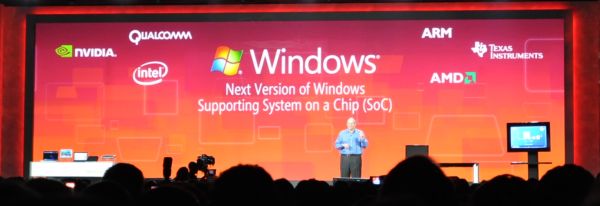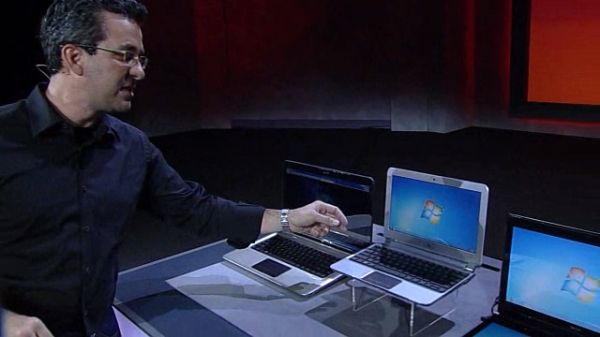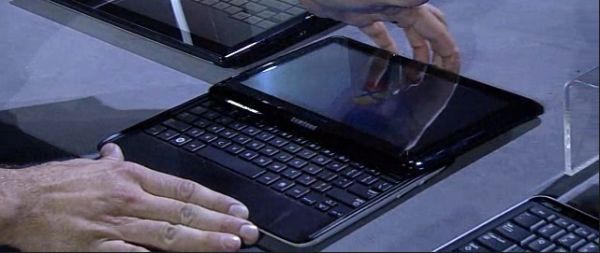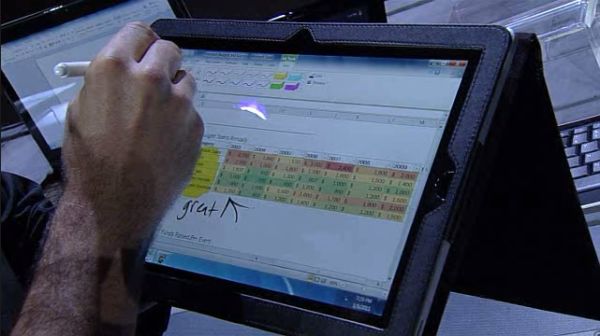
Original Link: https://www.anandtech.com/show/4101/ces-2011-microsoft-keynote
CES 2011: Microsoft Keynote
by Vivek Gowri & Ganesh T S on January 10, 2011 7:00 PM EST- Posted in
- Microsoft
- CES 2011
- Trade Shows
Windows 8 on SoCs
The big news was Microsoft demonstrating Windows 8 running on a variery of SoC platforms at the event. All demos were on development boards, though a final sample board for the x86 Atom based SoC was also shown (to stress the fact that Windows 8 could actually run on 'PCs' on a credit card sized board).
The first demo was on a x86 Atom based SoC (probably Moorestown) running Quicken, stressing the fact that the x86 platform is not something Microsoft is willing to alienate yet.
There were three more ARM based SoC platforms, each of which was used to demonstrate different Windows aspects. The Qualcomm Snapdragon chipset just showed the Windows desktop, while the TI OMAP platform was used to demonstrate the porting of a printer driver. The Tegra 2 platform was used to demonstrate HD video decoding and playback on Windows.
While people may find it impressive that the demo was able to show printing from an ARM based SoC, it is not really surprising given that the drivers for printers have already existed for a long time on Windows Embedded. It should also be noted that the core Windows kernel used to support a variety of architectures such as MIPS, Alpha and PowerPC till NT 4.0.
It is nice to see Windows running on ARM, but is it something that people want to see on systems based on such SoCs? In fact, the only sort of systems where we would like to see this are dockable smartphones similar to the Tegra 2 based Motorola ATRIX 4G.
ARM based SoCs are used for a variety of purposes, and as long as manufacturers restrict running Windows 8 on them only for the appropriate products, consumers should remain happy.
New Windows-based Systems
Microsoft was pretty excited to introduce some new systems based around the latest technologies from its main partners. First they showed off some new notebooks running Sandy Bridge, which we've covered extensively in the past. From there, Microsoft moved on to HP's new DM1, which is based on AMD's line of Fusion mobile APUs. The DM1 starts at $449, and houses an 11.6" WXGA display in an attractive enclosure. Inside, there's the AMD Vision E-350, which has two 1.6GHz cores and a Radeon HD 6310 on board. HP is claiming 9.5 hours of battery life on the standard 6 cell, 55 Wh battery, which is competitive with Atom and pretty impressive if that figure holds up in real life testing.
Obviously, the big thing at CES this year is tablets, and Microsoft has their fair share of them to trot out. On stage, they started with the 14" Acer Iconia dual-screen tablet. Spec-wise, it's a pretty standard mid-range notebook, with a Core i5 processor, Intel's onboard graphics, 4GB memory, and a 750GB hard disk. The real story is in the twin WXGA capactive touchscreens that enable some innovative new input methods. However, it's still just a concept device for now.
Next up was the Samsung Sliding PC 7 Series, which is a new kind of convertible tablet. Similar in concept to the ASUS Slider tablet that was announced earlier at CES, the Sliding PC 7 Series (no, I did not make that name up) is a standard tablet in which the screen slides up to reveal a netbook sized keyboard and then tilts forward to become a regular notebook-like system. The Sliding 7 is an Oak Trail-based system, running the 1.66GHz Z670 processor with a 10.1" WXGA touchscreen, 2GB memory, 32GB and 64GB SSD options, Windows 7, and a $699 pricetag. According to Samsung, it will boot in under 20 seconds and has a 9 hour battery. Quite frankly, I'm in love. We managed to get some hands on impressions of the device later on at the Intel booth; I'll give you more details in a future post.
Lastly, Microsoft showcased ASUS' EP121 tablet. We already looked at this one in our ASUS tablet annoucement post, but we got some hands on time as well, so let's reiterate - it's nice. It's absolutely jam packed with features, and it's not terribly expensive for what it is. The Core i5 UM processor, IPS display, and Wacom digitizer are a combination of features that really wins the high-end tablet market, so it's not suprising that Microsoft chose to highlight it in their keynote. But the overall takeaway here is that Microsoft seems pretty excited with the direction that Windows 7-based systems are going, with new form factors and plenty of exciting technologies being developed and released at a very rapid rate.











